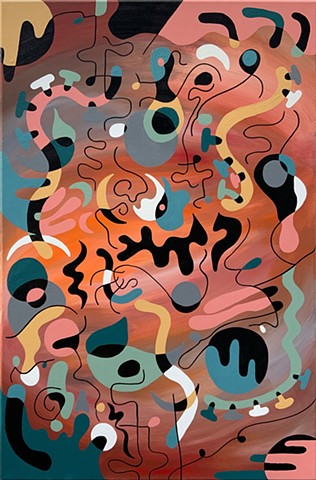Jesse McBrearty
Jesse McBrearty
Artist’s Statement
It has been difficult to approach the art-making process during this time. Juggling the challenges of adapting to the new normals of a pandemic-driven life has been destabilizing, to say the least. There is such a cloud of uncertainty surrounding the future that I find myself incapable of judging what is going to happen next. Time right now feels simultaneously static and wavering, and as a person who heavily relies on order and routine for mental clarity, the sudden disjunction between my ability to plan for the future, and how the future is actually panning out, has left me feeling constantly ungrounded.
In this context, I have found myself deeply anchored to the world of Surrealism as a way to communicate and think. There is certain humor that flows from Miró’s witty and whimsical imagery that has helped me approach the seriousness of this time in a more lighthearted way. Through my Surrealist-inflected images, I, too, am trying to redefine the beauty of art-making on a personal level.
As contrarian as it might sound, I have found some relief in the Art for Art’s Sake attitude. Their concentration on beauty, as well as their all-encompassing ethos, has helped animate my motivation for art-making. Though it has become quite an unfashionable way of thinking about art in recent decades, I find their attention to detail and craft particularly inspiring. Thus, my body of work is more about my process of creation — in order to reframe my reliance on an organized structure — than anything else. I suppose I am also taking a page out of Miró’s book by making light out of an extremely serious time: if my life can’t have the order, logic, and crispness that I desire it to, at least my art can.
As I’ve realized this past year that it is easier to take life day-by-day, I have found routine, and — dare I say — beauty, in my art-creation process. With a few hours on Procreate, I’ll start by choosing a color palette and a format, and let my mind wander from there. Looking at objects around me, one particular curve or edge will catch my eye, and I will render it abstractly until I eventually synthesize biomorphic and mechanical forms. The process of physically painting each piece then becomes a type of meditation for me, in which I can arrange my increasingly disordered thoughts into a physically stable and ordered system of patterns and colors. This has ultimately provided me with a renewed sense of excitement and motivation in my art-creation process.
